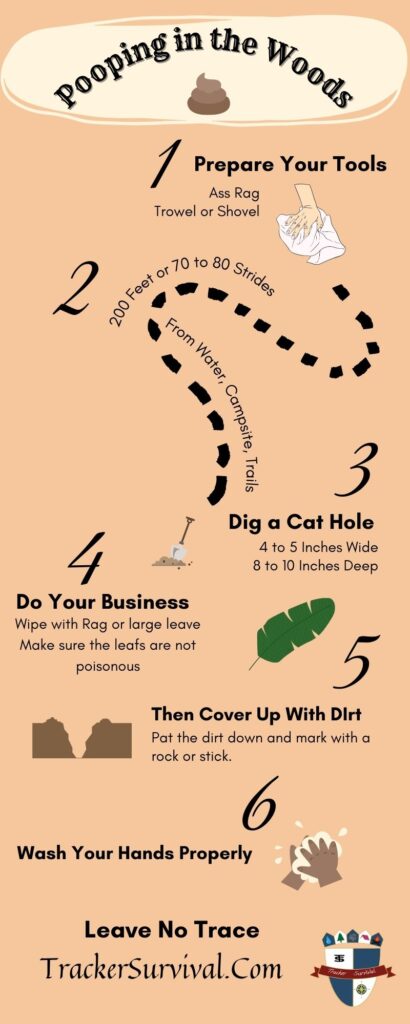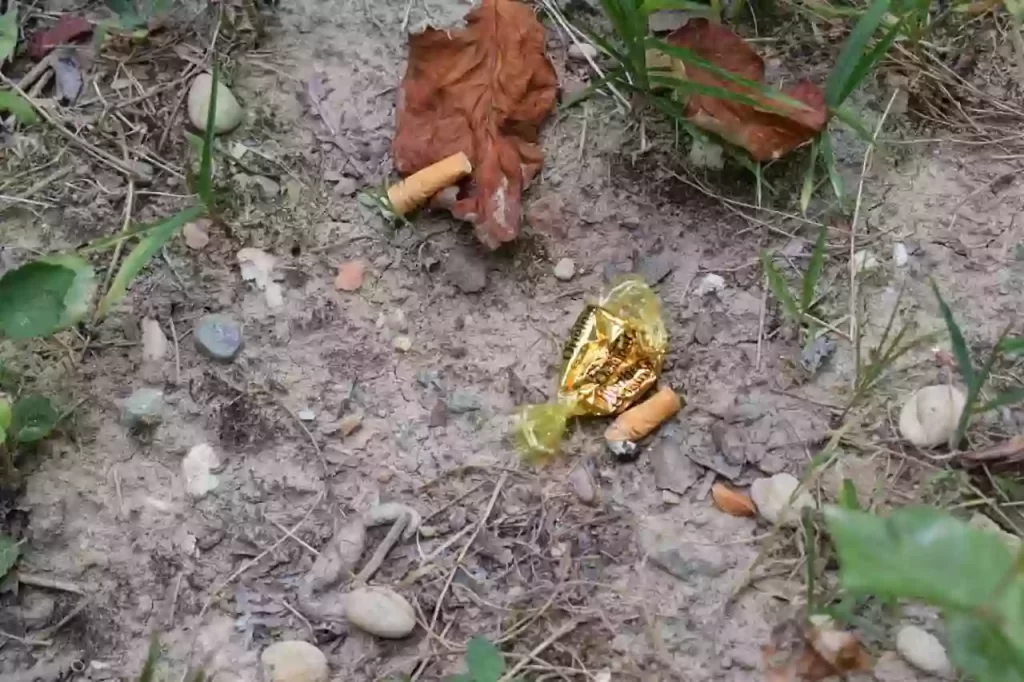Basic Outdoors Sanitation
Everyone is curious. But no one discusses what to do with human waste, how to wash up, and how to dispose of meal remnants. In an outdoor survival situation. Basic outdoors Sanitation isn’t as easy as flushing it down the toilet and washing your hands in the bathroom sink after.
Rule number 1 ( Leave no Trace)
Pooping In The Woods
How to poop in the woods is one of the least asked questions. But it is something people worry about before going on a camping trip.
How to go to the bathroom in the woods? Basic sanitation is essential, be it on a camping trip or in a survival situation. This is not something much talked about, and not something you are going to learn about by watching movies. But it is natural and everyone has to go sooner or later.
Plastic Poop Bags
Following the ethos of leave no trace, the optimal option is to carry plastic bags, poop in them, and wipe. Then pack and carry the whole thing out with you when you leave. This of course applies to camping or hiking.
In a survival situation, the chances of you having these handy Go Anywhere Toilet Kits are slim.

Choosing Your Toilet Site
If carrying your waste out is not an option, burying it in the woods is your only choice.
At least 200 feet away (about 70 to 80 steps depending on your stride) from any water source, trail, or campsite.
Choose somewhere in direct sunlight, preferably loose soil, which makes it easier to dig and the waste decomposes faster in loose soil.
Dig A Cat Hole
Dig a cat hole, about 4 to 5 inches wide and 8 to 10 inches deep.
After you are done, cover the hole with the dirt you dug up. Tap it down and place a marker over it (a rock or a stick). So you or another person doesn’t accidentally dig it up when you or the other person needs to go.
Toilet Paper
Not sustainable in the long run, there is only so much toilet paper you can carry with you. Alternatives are out there, leaves (make sure they are not irritants or even worst poisonous), smooth stones, and even snow if there is any around. If you are hiking or camping and you do have toilet paper with you. Do NOT bury it outdoors. Carry it in a re-sealable bag and dispose of it when you get home.
Ass Rag
This is a term that I first heard from watching a survival video by legendary survivalist Ron Hood. It’s a simple piece of cloth that is used as toilet paper and then washed. Usually hung on the outside of the pack (preferably in a plastic bag after it has been dried). A popular solution that survivalists use.
Peeing In The Woods
Well going number one, is much easier. Peeing in the woods is mostly just a matter of finding the right spot. Follow the same rules regarding choosing a good location. Away from any water source, off the trail, and away from the campsite.
Luckily you don’t have to dig a hole to pee. I think most of us have at one time or another found ourselves outdoors and had to pee. So this shouldn’t be too difficult. Just make sure to wash your hands after.
Bathing In The Outdoors
Basic rules of cleaning up in the outdoors.
Never use any soaps or shampoos directly in a river, lake, or stream. Even biodegradable soaps and shampoos may harm wildlife.
Instead of bathing in a lake or running water, collect water in a container and bathe away from any water source. Pour the dirty water on a rock that does not have moss or lichen on it.
Optimally you will have a solar shower in your bug-out bag if not, a large plastic bag with a few holes pocked in it will server the same function. And that will make your showering needs much simpler.
Survival Vs Camping Rules
In a life or death survival situation, you are of course going to be a little more lax with the rules of conservation. But if you are camping or hiking. Remember the number one rule “Leave No Trace”.
This means everything, not only the big trash but the little micro trash that most people take for granted. Cigarette butts, peanut shells, sunflower seeds, soft drink tabs. Pack them all up and dispose of them when you get home. Basic outdoors sanitation is not only about keeping yourself clean. But also about keeping your environment pristine.

Cleaning Pots, Pans And Utensils
Keeping your cookware clean outdoors is essential. One of the best ways to clean up after cooking is just to scrub the pans and dishes and then pour boiling water on them to clean up. Be extra careful when disposing of scraps. Either leave no scraps behind (eat them all) or make sure to filter and dispose of them. Animals have an amazing sense of smell, even the tiniest scraps of food can attract wildlife. And you don’t want to wake up in the middle of the night to find a predator such as a bear rummaging around your campsite looking for leftovers.
Washing Clothes In The Outdoors
Have you ever watched a movie with women pounding their clothes on a river bank? Yes, that will wash your clothes. At the same time, it will pollute the water. Water that you will most probably rely on as your source of drinking water. It may also be a source of protein, fishing is always a good idea in rivers or lakes.
Washing your clothes with any detergent, even the special biodegradable ones will affect the ecosystem.
Best practices: boil water over a fire,
add a little bit of detergent (preferably biodegradable) into a bucket. Stick your clothes into it, and stir vigorously with a stick. Once the water cools enough scrub your clothes with your hands. Carry the water and your clothes 200 feet from your campsite, rinse once or twice, then hang up to dry. For how to start a fire in the outdoors have a look at the key to survival is a good fire.